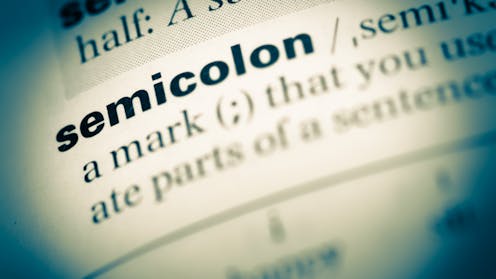Semicolons are becoming increasingly rare; their disappearance should be resisted
- Written by The Conversation

A recent study has found a 50% decline in the use of semicolons over the last two decades. The decline accelerates a longterm trend:
In 1781, British literature featured a semicolon roughly every 90 words; by 2000, it had fallen to one every 205 words. Today, there’s just one semicolon for every 390 words.
Further research reported that 67% of British students never or rarely use a semicolon; more than 50% did not know how to use it. Just 11% of respondents described themselves as frequent users.
These findings may not be definitive. According to the Guardian, the Google Books Ngram Viewer database, which surveys novels and nonfiction, indicates that
semicolon use in English rose by 388% between 1800 and 2006, before falling by 45% over the next 11 years. In 2017, however, it started a gradual recovery, with a 27% rise by 2022.
Yet when you put the punctuation mark itself into the database, rather than the word “semicolon”, you get a quite different result – one that looks very much like a steady decline.
Virulent detractors
The semicolon first appeared in 1494, so it has been around for a long time. So have arguments about it.
Its dectractors can be quite virulent. It is sometimes taken as a sign of affected elitism. Adrian Mole, the pretentious schoolboy protagonist of Sue Townsend’s popular novels, says snobbishly of Barry Kent, the skinhead bully at his school: “He wouldn’t know what a semicolon was if it fell into his beer.” Kurt Vonnegut (whose novels are not entirely free of semicolons) said semicolons represented “absolutely nothing” and using them just showed that you “went to college”.
Other writers have expressed pure animosity. American journalist James Kilpatrick denounced the semicolon “girly”, “odious”, and the “most pusillanimous, sissified utterly useless mark of punctuation ever invented”.
The utility of this much maligned punctuation mark in contemporary prose has been called into question. British author Ben McIntyre has claimed Stephen King “wouldn’t be seen dead in a ditch with a semicolon”.
He obviously hasn’t read page 32 of King’s wonderful book On Writing, where King uses semicolons in three sentences in a row.
Impeccable balance
Before I defend the semicolon, it is worth clarifying what it actually does. Its two uses are as follows:
1) it separates independent clauses, but establishes a relation between them. It suggests that the statements are too closely connected to stand as separate sentences. For example: “Speech is silver; silence is golden.”
2) it can be used to clarify a complicated list. For example: “Remember to check your grammar, especially agreement of subjects and verbs; your spelling, especially of tricky words such as ‘liaison’; and your punctuation, especially your use of the apostrophe.”
Semicolons have long played a prominent role in classic literature. Journalist Amelia Hill notes that Virginia Woolf relies heavily on semicolons in her meditation on time, Mrs Dalloway. The novel includes more than 1000 of them, often used in unorthodox ways, to capture the flow of its protagonist’s thoughts.
Other supporters of the semicolon include Salman Rushdie, John Updike, Donna Tartt, Mark Twain, Charles Dickens and Jane Austen. Novelist Philip Hensher has celebrated the semicolon as “a cherished tool, elegant and rational.” In 1953, theatre critic Kenneth Tynan called it “the prize-winning supporting crutch of English prose”.
In his essay Semicolons: A Love Story, Ben Dolnick refers to William James’s deft use of semicolons to pile on the clauses. He claims this is like saying to a reader, who is already holding one bag of groceries, “Here, I know it’s a lot, but can you take another?”
“The image of the grocery bags,” observed Mary Norris, a highly respected copyeditor at the New Yorker, “reinforces the idea that semicolons are all about balance.” Harvard professor Louis Menand has praised as “impeccable” the balancing semicolon on a public service placard (allegedly amended by hand) that exhorted subway riders not to leave their newspapers behind on the train: “Please put it in a trash can; that’s good news for everyone.”
The poet Lewis Thomas beautifully captures the elegance of a well-used semicolon in his essay Notes on Punctuation:
The semicolon tells you there is still some question about the preceding full sentence; something needs to be added. It is almost always a greater pleasure to come across a semicolon than a full stop. The full stop tells you that is that; if you didn’t get all the meaning you wanted or expected, you got all the writer intended to parcel out and now you have to move along. But with a semicolon there you get a pleasant little feeling of expectancy; there is more to come; read on; it will get clearer.
As Australian novelist David Malouf has argued, the semicolon still has a future, and an important function, in nuanced imaginative prose:
I tend to write longer sentences and use the semicolon so as not to have to break the longer sentences into shorter ones that would suggest things are not connected that I want people to see as connected. Short sentences make for fast reading; often you want slow reading.
We cannot do without the semicolon. The Apostrophe Protection Society is going along very strongly. I would be more than happy to join a Semicolon Supporting Society.







